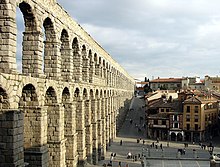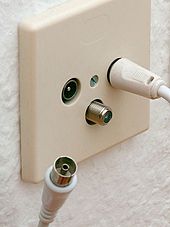Line network
Line network serves as a generic term for several, systematically connected lines that are used to supply and dispose of liquid or gaseous substances, energy or information. Typical examples are the networks for drinking water supply , wastewater disposal , energy supply and line-based networks for the exchange of information. Pipeline networks are an important part of a civilization .


Historical development
The oldest records about piping systems come from the time of the Egyptian pharaoh Ramses II , around 1300 BC. And were used to supply water to larger settlements. For the water supply of Nineveh , the Assyrian king Sennacherib ordered in 691 BC. Build a 48 kilometer long aqueduct with a 280 meter long and 9 meter high bridge with five openings over a valley. With the emergence of cities, a secure water supply for the residents became essential. The Romans in particular created extensive aqueducts as pipe networks for supplying water to their cities. In Pergamon there were already pressurized water pipes to supply households. Even the irrigation system of Turpan in China is of great antiquity. In the Middle Ages, wooden pipelines , the pipes, were used. Pipeline networks for irrigation and drainage also play a central role in agriculture .
With the use of the steam engine , powerful pumping systems became available. This enabled pipeline networks in new dimensions and drove generators to generate electrical energy, which was transported and distributed in power networks and also revolutionized the transmission of messages. For the electric Morse code telegraph and the teleprinter , completely new line networks were implemented for the transmission of information, which from 1881 formed the basis for the later telephone networks and current communication networks .
structure
A basic distinction should be made between:
- Networks for material material and material energy transport
- Line networks for the transport of electrical energy
- Transmission of messages / information in communication networks
Pipeline networks for material and material energy transport
The beginnings were the construction of open water pipes as water ditches , supplemented if necessary by water tunnels and aqueducts (water bridges). In addition to the transport of drinking water, the transport of water as an energy source in man-made trenches also gained increasing importance. The aim was to obtain as great a difference in height as possible from the lower drain ( surcharge ) at the location of a hydropower machine in order to maximize the energy yield. As a rule, it was an open gravity pipeline in which the liquid is transported by gravity. At that time, the water from these pipeline networks mainly drove prime movers in mining, such as B. artificial wheels , sweepers , water column machines or turbines that drove the industrial revolution . Open systems are still used in sewage networks, for example , but they only play a subordinate role today. Pressure lines are mainly used. Smaller pressure pipe networks are used, for example, in hospitals for oxygen supply or in workshops for compressed air distribution as drive energy. District heating networks are used to supply heat energy.
The drinking water is supplied via a widely branched water distribution system .
Pipelines are used to transport liquids and gases ( long-distance gas ) over long distances under pressure and are usually connected to networks to increase security of supply and linked to regional distribution networks via pressure reducers and distribution stations.
Line networks transport and distribution of electrical energy
Power grids with overhead lines and underground cables at different voltage levels are used to transport and distribute electrical energy. In Germany, electricity is transported over longer distances by only four transmission network operators . A large number of distribution network operators are responsible for power distribution at regional level .
Line networks for communication
The telephone network as a distribution network on an electrical or optical line basis is used for the transmission and distribution of information worldwide. Originally conceived as an analog transmission path, the conversion to digital transmission technology enables significant improvements in transmission quality and in the possible transmission volumes. ADSL technology enables the simultaneous use of voice and information transmission . The wired network is supplemented by wireless communication channels such as radio and satellite networks.
Originally, access to radio and television services was primarily implemented in cities via coaxial cable networks . After extensive expansion to broadband technology and digitization, these cable networks now offer comprehensive access to information and communication services via cable modems and are therefore in some cases competing with telephone networks.
Individual evidence
- ↑ Die Große Chronik Weltgeschichte, Vol. 4, p. 112: Nineveh receives an aqueduct , ISBN 978-3-577-09064-3 , accessed March 5, 2012.
- ↑ T. Jacobsen, H. Frankfort: Sennacherib's Aqueduct at Jerwan (PDF; 18.3 MB), Publications of the Oriental Institute of the University of Chicago, Volume 24 1935.
- ↑ Antikefan: Ancient water supply in March, added the fifth 2012th
- ^ Bayern online: History of telecommunications up to 1999 , inserted March 5, 2012.




